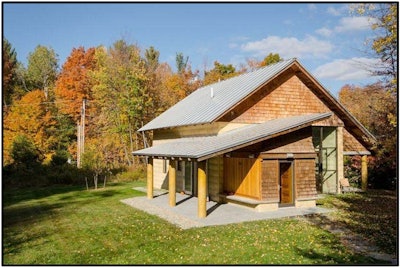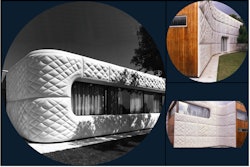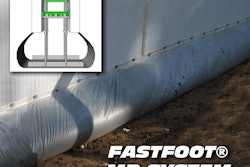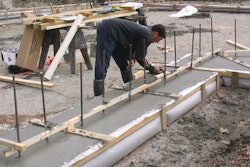
A paper by D. Veenendaal et al.1 gives a detailed historical perspective of innovators who have proceeded us using fabric as part of their building forming systems, as hydraulic and geotechnical structures, as form liners and as the membrane in their pneumatic formed structures. Most influential were those innovators who used woven geotextiles for their civil engineering works such as revetments, underwater pile jackets, pond liners and coastal and river structures. Their research found that geotextiles offered superior concrete finish and durability, had exceptional strength and were a very economical way for containing concrete.2 Additionally those applications where fabrics were used as form liners, were also shown to improve the surface quality and finish of the cast concrete member. They set the stage for today’s researchers.
Throughout the 20th century, a number of innovators experimented with fabric as a flexible membrane for the support of fluid concrete, forming structural members.
Despite decades since, visionaries such as Heinz Isler and Antoni Gaudi used hanging chains and fabrics to visualize their shell structures. Computational analysis still presents a challenge for structural members cast directly into a flexible membrane.3, 4, 5 The author and several others have explored the analysis of these complex forms.6, 7, 8 My research involved the development of an FEM (finite element method) procedure to design a fabric cast wall panel.9, 10 Straightforward methods of analysis and design are available for the conventionally cast concrete wall or floor panel. This is not the case for the wall panel cast in a flexible fabric formwork.
It bears worth repeating that while it is true that a flexible fabric formwork may be used nearly anywhere a rigid formwork is used, a significant amount of research remains to be done to bring these systems into everyday practical use by the construction industry. Standards and guidelines for using flexible fabric formworks need to be developed for the design community to take full advantage of this unique method of forming concrete members and feel comfortable using it. We recognize that wood and/or metal used for forming will not be eliminated by using fabric but can be reduced to essential components thereby saving natural resources.
There are a number of issues and hurdles to be overcome before architects, engineers and especially concrete contractors are accepting of this unique method of forming concrete.
While geotextile fabric as a formwork has a number of distinct advantages including:
- The possibility to form very complex shapes.
- It is strong, lightweight, inexpensive, reusable and will not propagate a tear.
- Less concrete and reinforcing are required resulting in a conservation of materials.
- Filtering action of the fabric improves the surface finish and member durability. 2, 11, 12
It also has several disadvantages including:
- Relaxation can occur due to the pre-stress forces in the membrane.
- The potential for creep in the geotextile material, which can be accelerated by an increase in temperature as might occur during hydration of the concrete as it cures.
- The concrete must be placed carefully and the fabric formwork not jostled while the concrete is in a plastic state.
However, until new fabrics are developed the benefits of using geotextiles far outweighs any disadvantages. In addition, unless standards and guidelines for use in precast and cast-in-place forming systems are developed this method of forming concrete will remain a niche market exploited only by those brave and bold enough to challenge the status quo. To be of practical use to the design community some standardization of systems and guidance are needed for contractors to feel comfortable using flexible formworks.
After reviewing recent e-mail correspondence from three of the leading proponents of fabric formwork regarding their thoughts on the future of fabric-formed concrete, Richard Fearn of Fab-Form Industries and Professors Remo Pedreschi and Mark West, I get the impression that making an immediate and significant industry impact is indeed difficult. All three indicate that the very nature of the marketplace is complex and that for the builder, who may be selected solely based on his/her low bid, he/she may be reluctant to take on an unknown system. There is a risk involved when pursuing new means of construction. However, Professor Pedreschi says we should not see fabric formwork as a replacement but a new “disruptive technology” that offers us the opportunity to design formwork in a new way.
Conclusions
To date, three fabric-formed concrete conferences have been held. From these dedicated conferences have come more than 75 papers and presentations on this topic. Therefore, it would appear, from at least the international scene, the movement, if it can be called that, is alive and well.
Is there a future for fabric-formed concrete structures? Given the current level of research and enthusiasm that was expressed at the most recent conference; the answer is maybe. Practitioners, architects, engineers and contractors have yet to embrace this forming method as a replacement for or an addition to their conventional formwork systems. The current disconnect between academia and industry needs to be overcome. From a practical point of view, the answer may be one where fabric formworks do not replace but supplement conventional forming methods.
This fabric forming concrete method has special properties, structural advantages unique to its use as outlined above and we fully expect to see it grow beyond the “niche” or novelty forming method marketplace it currently occupies. It will just take collaboration with industry and time.
Ed. Note: An Introduction to Fabric-Formed Concrete for Architectural Structures - Part 1 appeared in the February/March 2016 issue of Concrete Contractor.
Readers interested in additional information are encouraged to visit the following websites:
- Author’s research dedicated website: http://www.fabwiki.fabric-formedconcrete.com/
- The International Society of Fabric Forming (ISOFF): http://www.fabricforming.org/
Robert P. Schmitz, P.E. is a registered professional engineer in the State of Wisconsin, USA with more than thirty-five years experience in architecture and structural engineering. His research interest in fabric formwork comes as a result of work he completed for his Master’s degree and his desire to see this unique method of forming concrete brought into mainstream construction practice. He is a member of ASCE and ACI. He can be reached via e-mail at [email protected].
References:
1. Veenendaal, D. & West, M. & Block, P. 2011. History and overview of fabric formwork: using fabrics for concrete casting. Structural Concrete: Journal of the fib, 12 (3): pp. 164–177.
2. Lamberton, B.A. 1989. Fabric Forms for Concrete. Concrete International. 11 (12): pp. 58-67.
3. Chilton, J. 2012. Form-finding and fabric forming in the work of Heinz Isler. In: Orr, J., Evernden, M., Darby, A. & Ibell, T. (eds.) icff 2012: Proceedings of the Second International Conference on Flexible Formwork, ICFF 2012, 27-29 June 2012, Bath, UK. University of Bath, BRE CICM. pp. 84-91.
4. Bechthold, M. 2008. Innovative Surface Structure Technologies and Applications. Abingdon, Oxon & New York: Taylor & Francis.
5. Billington, D.P. 1983. The Tower and the Bridge. New York: Basic Books, Inc.
6. Bhooshan, S. & El Sayed, M. 2012. Sub-division Surfaces in Architectural Form Finding and Fabric Forming. In: Orr, J., Evernden, M., Darby, A. & Ibell, T. (eds.) icff 2012: Proceedings of the Second International Conference on Flexible Formwork, ICFF 2012, 27-29 June 2012, Bath, UK. University of Bath, BRE CICM. pp. 64-74.
7. Veenendaal, D. & Block, P. 2012. Computational form-finding of fabric formworks: an overview and discussion. In: Orr, J., Evernden, M., Darby, A. & Ibell, T. (eds.) icff 2012: Proceedings of the Second International Conference on Flexible Formwork, ICFF 2012, 27-29 June 2012, Bath, UK. University of Bath, BRE CICM. pp. 368-378.
8. Veenendaal, D. 2008. Evolutionary Optimization of Fabric Formed Structural elements. Master’s thesis, Delft University of Technology, Delft, the Netherlands.
9. Schmitz R.P. 2004. Fabric-Formed Concrete Panel Design. Master’s thesis, Milwaukee School of Engineering, Milwaukee, Wisconsin.
10. Schmitz R.P. 2006. Fabric-Formed Concrete Panel Design. In: Charney, F.A. & Grierson, D.E. & Hoit, M. (eds.) Proceedings of the 17th Analysis and Computation Specialty Conference, 2006 Structures Congress, 18-21 May 2006, St. Louis, Missouri. CDROM published by American Society of Civil Engineers.
11. Abdelgarder, H.S. & El-Baden, A.S. 2012. Effect of fabric types on the compressive strength of concrete. In: Orr, J., Evernden, M., Darby, A. & Ibell, T. (eds.) icff 2012: Proceedings of the Second International Conference on Flexible Formwork, ICFF 2012, 27-29 June 2012, Bath, UK. University of Bath, BRE CICM. pp. 20-24.
12. Delijani, F. 2010. The Evaluation of Changes in Concrete Properties Due to Fabric Formwork. Master’s thesis, Department of Civil Engineering, University of Manitoba, Winnipeg, Canada.


















